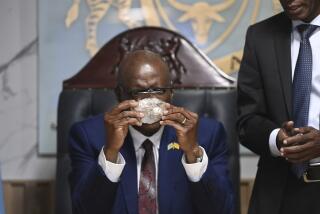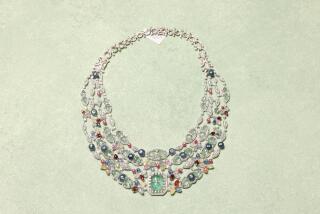Deadly Toll of ‘Blood Diamonds’
- Share via
Diamonds are a best friend, indeed--of warlords, gunrunners, smugglers and drug traffickers. Before they reach the jewelry counter, many diamonds--nobody really knows how many--bankroll some of Africa’s bloodiest insurgencies. Belatedly, the world is waking up to the suffering these “blood diamonds” cause.
The U.N. Security Council earlier this month agreed to a ban on trade in rough diamonds from Sierra Leone. The diamond industry is meeting today in Antwerp, Belgium, the world’s largest diamond processing center, to tighten controls on illicit diamond trade. The U.N. ban helps but should be extended to Liberia and Guinea, the main smuggling routes for Sierra Leone’s diamonds. The additional measures that industry and government take must plug the leaks that allow diamond trafficking to fuel wars in Africa and must punish those who trade in such diamonds.
For the last nine years, rough diamonds dug up in the rich Kono district mines of eastern Sierra Leone financed a brutal civil war waged by Foday Sankoh’s Revolutionary United Front. His boy-soldiers, in a campaign of random terror, specialize in cutting off the hands of men, women and children. As rebel documents published by the Financial Times newspaper last week revealed, thousands of diamonds from Kono mines, which are under rebel control, are being smuggled to Liberia or Guinea and then, with the help of corrupt customs and police officers, shipped to Antwerp or Tel Aviv, the main trading centers. Everyone gets a cut, but the bulk of the proceeds pays for smuggled guns.
In the same way, illicit diamond trading has fueled violent conflicts in Angola--which have cost more than 500,000 lives--and Congo. The U.N. banned trading in Angolan diamonds in 1998, but smuggled gems continue to supply Jonas Savimbi’s UNITA rebels with all the cash they need. In neighboring Congo, the diamond trade is at the center of a two-year war in which more than 1,000 people die each week. The war has sucked in the entire region, with Zimbabwe, Angola and Namibia fighting on the side of Laurent Kabila’s government, and Rwanda, Uganda and Burundi siding with Congolese rebels.
Far too little has been done to stop the trade in blood-stained gems. De Beers, the South African diamond mining company that controls nearly two-thirds of the rough diamond market and is under a 1994 U.S. indictment on charges of price fixing, did little until last fall to stop the illicit trade. Now, fears of a consumer boycott have prompted De Beers and others in the industry to stop trading in diamonds from the conflict regions of Africa. Last month, the industry agreed on a plan to ship diamonds in sealed packages along with certificates of origin. The scheme, however, has not been signed by Israel, a chief diamond processor, and Russia, the world’s second-largest diamond producer.
Though not foolproof, tracking diamonds from mine to retailer, combined with an industrywide boycott of conflict diamonds, would be a big step toward effective global control. U.N. sanctions vigorously enforced by national governments also would help but must be extended to trafficking countries.
For far too long, the diamond trade has paid no attention to the suffering its product causes. It has a lot of lost time to make up.
More to Read
Sign up for Essential California
The most important California stories and recommendations in your inbox every morning.
You may occasionally receive promotional content from the Los Angeles Times.













